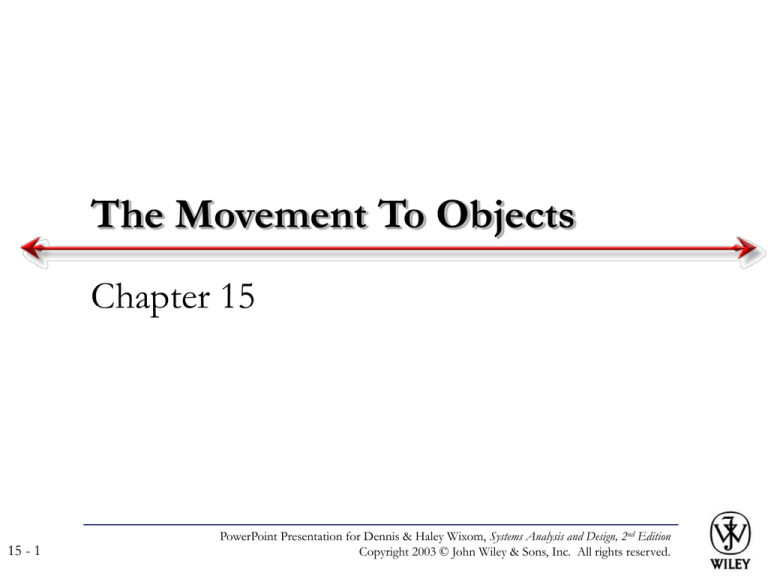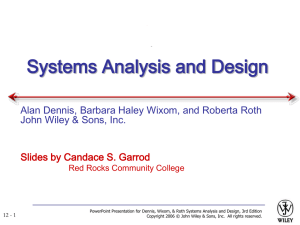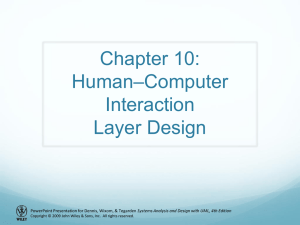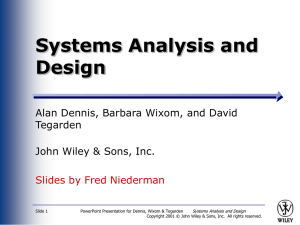
The Movement To Objects
Chapter 15
15 - 1
PowerPoint Presentation for Dennis & Haley Wixom, Systems Analysis and Design, 2nd Edition
Copyright 2003 © John Wiley & Sons, Inc. All rights reserved.
Key Definitions
Object-oriented techniques view a system
as a collection of self-contained objects
which include both data and processes.
The Unified Modeling Language (UML)
the object modeling standard
adds a variety of techniques to the field of
system development.
15 - 2
PowerPoint Presentation for Dennis & Haley Wixom, Systems Analysis and Design, 2nd Edition
Copyright 2003 © John Wiley & Sons, Inc. All rights reserved.
THE OBJECT APPROACH
AND UML
15 - 3
PowerPoint Presentation for Dennis & Haley Wixom, Systems Analysis and Design, 2nd Edition
Copyright 2003 © John Wiley & Sons, Inc. All rights reserved.
Object Concepts
An object is a person, place, event, or thing about which we
want to capture information.
Each object has properties (or attributes).
The state of an object is defined by the value of its properties
and relations with other objects at a point in time.
Objects have behaviors -- things that they can do -- which are
described by methods (or operations).
Objects do not use primary or foreign keys, instead each
instance is assigned a unique identifier (UID) when it is
created.
15 - 4
PowerPoint Presentation for Dennis & Haley Wixom, Systems Analysis and Design, 2nd Edition
Copyright 2003 © John Wiley & Sons, Inc. All rights reserved.
An Object and Object Instances
15 - 5
PowerPoint Presentation for Dennis & Haley Wixom, Systems Analysis and Design, 2nd Edition
Copyright 2003 © John Wiley & Sons, Inc. All rights reserved.
Class
A class is a general template we use to
define and create specific instances or
objects.
15 - 6
PowerPoint Presentation for Dennis & Haley Wixom, Systems Analysis and Design, 2nd Edition
Copyright 2003 © John Wiley & Sons, Inc. All rights reserved.
Classes and Objects
15 - 7
PowerPoint Presentation for Dennis & Haley Wixom, Systems Analysis and Design, 2nd Edition
Copyright 2003 © John Wiley & Sons, Inc. All rights reserved.
Class Hierarchy
15 - 8
PowerPoint Presentation for Dennis & Haley Wixom, Systems Analysis and Design, 2nd Edition
Copyright 2003 © John Wiley & Sons, Inc. All rights reserved.
Messages
Messages are information sent to objects
to trigger methods
15 - 9
PowerPoint Presentation for Dennis & Haley Wixom, Systems Analysis and Design, 2nd Edition
Copyright 2003 © John Wiley & Sons, Inc. All rights reserved.
Encapsulation
The message is sent without considering
how it will be implemented
The object can be treated as a “blackbox”
15 - 10
PowerPoint Presentation for Dennis & Haley Wixom, Systems Analysis and Design, 2nd Edition
Copyright 2003 © John Wiley & Sons, Inc. All rights reserved.
Inheritance
Classes are arranged in a hierarchy
Superclasses or general classes are at the top
Subclasses or specific classes are at the bottom
Subclasses inherit attributes and methods from
the superclasses above them
Classes with instances are concrete classes
Abstract classes only produce templates for more
specific classes
15 - 11
PowerPoint Presentation for Dennis & Haley Wixom, Systems Analysis and Design, 2nd Edition
Copyright 2003 © John Wiley & Sons, Inc. All rights reserved.
Inheritance
15 - 12
PowerPoint Presentation for Dennis & Haley Wixom, Systems Analysis and Design, 2nd Edition
Copyright 2003 © John Wiley & Sons, Inc. All rights reserved.
Polymorphism
15 - 13
PowerPoint Presentation for Dennis & Haley Wixom, Systems Analysis and Design, 2nd Edition
Copyright 2003 © John Wiley & Sons, Inc. All rights reserved.
Benefits of an Object Approach
Benefits of an Object Approach
An Object
A class
Inheritance
Polymorphism
Encapsulation
15 - 14
What Do the
Concepts
Support
and Lead
To?
PowerPoint Presentation for Dennis & Haley Wixom, Systems Analysis and Design, 2nd Edition
Copyright 2003 © John Wiley & Sons, Inc. All rights reserved.
Unified Modeling Language - UML
Defines a set of nine object diagramming
techniques
The key building block is the use case
Diagrams are tightly integrated
syntactically and conceptually to represent
an integrated whole
Application of UML can vary among
organizations
15 - 15
PowerPoint Presentation for Dennis & Haley Wixom, Systems Analysis and Design, 2nd Edition
Copyright 2003 © John Wiley & Sons, Inc. All rights reserved.
Adaptation of the Phased
Development Method
15 - 16
PowerPoint Presentation for Dennis & Haley Wixom, Systems Analysis and Design, 2nd Edition
Copyright 2003 © John Wiley & Sons, Inc. All rights reserved.
USE-CASE DIAGRAM
15 - 17
PowerPoint Presentation for Dennis & Haley Wixom, Systems Analysis and Design, 2nd Edition
Copyright 2003 © John Wiley & Sons, Inc. All rights reserved.
Use-Case Diagram Concepts
Summarizes all use cases (for the part of
the system being modeled) together in
one picture
Typically drawn early in the SDLC
Shows the associations between actors
and use cases
15 - 18
PowerPoint Presentation for Dennis & Haley Wixom, Systems Analysis and Design, 2nd Edition
Copyright 2003 © John Wiley & Sons, Inc. All rights reserved.
Integration of four UML
Diagrams
15 - 19
PowerPoint Presentation for Dennis & Haley Wixom, Systems Analysis and Design, 2nd Edition
Copyright 2003 © John Wiley & Sons, Inc. All rights reserved.
Use Case Diagram for
Appointment System
15 - 20
PowerPoint Presentation for Dennis & Haley Wixom, Systems Analysis and Design, 2nd Edition
Copyright 2003 © John Wiley & Sons, Inc. All rights reserved.
Syntax for Use-Case Diagram
15 - 21
PowerPoint Presentation for Dennis & Haley Wixom, Systems Analysis and Design, 2nd Edition
Copyright 2003 © John Wiley & Sons, Inc. All rights reserved.
Use-Case Diagram for Specialized
Actor
15 - 22
PowerPoint Presentation for Dennis & Haley Wixom, Systems Analysis and Design, 2nd Edition
Copyright 2003 © John Wiley & Sons, Inc. All rights reserved.
Extends or Uses Associations
15 - 23
PowerPoint Presentation for Dennis & Haley Wixom, Systems Analysis and Design, 2nd Edition
Copyright 2003 © John Wiley & Sons, Inc. All rights reserved.
Steps in Creating the Use Case
Diagram
1. Identify use cases
2. Draw the system boundary
3. Place use cases on the diagram
Group use cases into packages
Add special use case associations
4. Identify the actors
5. Add associations
15 - 24
PowerPoint Presentation for Dennis & Haley Wixom, Systems Analysis and Design, 2nd Edition
Copyright 2003 © John Wiley & Sons, Inc. All rights reserved.
CLASS DIAGRAM
15 - 25
PowerPoint Presentation for Dennis & Haley Wixom, Systems Analysis and Design, 2nd Edition
Copyright 2003 © John Wiley & Sons, Inc. All rights reserved.
Class Diagram Concepts
A static model that shows the classes and
relationships among classes that remain
constant in the system over time
Resembles the ERD, but depicts classes which
include both behaviors and states, while
entities in the ERD include only attributes
Scope not system wide, but pertaining to a
single use-case
15 - 26
PowerPoint Presentation for Dennis & Haley Wixom, Systems Analysis and Design, 2nd Edition
Copyright 2003 © John Wiley & Sons, Inc. All rights reserved.
Class Diagram for Manage
Appointment
15 - 27
PowerPoint Presentation for Dennis & Haley Wixom, Systems Analysis and Design, 2nd Edition
Copyright 2003 © John Wiley & Sons, Inc. All rights reserved.
Class Diagram Syntax
15 - 28
PowerPoint Presentation for Dennis & Haley Wixom, Systems Analysis and Design, 2nd Edition
Copyright 2003 © John Wiley & Sons, Inc. All rights reserved.
Method Types
Constructor methods create new instances of a
class
Query methods determine the state of an
object and make information about that state
available to the system
Update methods will change the value of some
or all of the object’s attributes, resulting in a
change of state
15 - 29
PowerPoint Presentation for Dennis & Haley Wixom, Systems Analysis and Design, 2nd Edition
Copyright 2003 © John Wiley & Sons, Inc. All rights reserved.
Multiplicity
15 - 30
PowerPoint Presentation for Dennis & Haley Wixom, Systems Analysis and Design, 2nd Edition
Copyright 2003 © John Wiley & Sons, Inc. All rights reserved.
Association Class
15 - 31
PowerPoint Presentation for Dennis & Haley Wixom, Systems Analysis and Design, 2nd Edition
Copyright 2003 © John Wiley & Sons, Inc. All rights reserved.
Aggregation and Generalization
Associations
15 - 32
PowerPoint Presentation for Dennis & Haley Wixom, Systems Analysis and Design, 2nd Edition
Copyright 2003 © John Wiley & Sons, Inc. All rights reserved.
Steps in Creating a Class Diagram
1. Identify classes
2. Identify attributes and operations
3. Draw relationships between classes
15 - 33
PowerPoint Presentation for Dennis & Haley Wixom, Systems Analysis and Design, 2nd Edition
Copyright 2003 © John Wiley & Sons, Inc. All rights reserved.
Class Diagram for Customer
Places Order (1)
15 - 34
PowerPoint Presentation for Dennis & Haley Wixom, Systems Analysis and Design, 2nd Edition
Copyright 2003 © John Wiley & Sons, Inc. All rights reserved.
Class Diagram for Customer
Places Order (2)
15 - 35
PowerPoint Presentation for Dennis & Haley Wixom, Systems Analysis and Design, 2nd Edition
Copyright 2003 © John Wiley & Sons, Inc. All rights reserved.
Class Diagram for Customer
Places Order (3)
15 - 36
PowerPoint Presentation for Dennis & Haley Wixom, Systems Analysis and Design, 2nd Edition
Copyright 2003 © John Wiley & Sons, Inc. All rights reserved.
SEQUENCE DIAGRAM
15 - 37
PowerPoint Presentation for Dennis & Haley Wixom, Systems Analysis and Design, 2nd Edition
Copyright 2003 © John Wiley & Sons, Inc. All rights reserved.
Sequence Diagram Concepts
Illustrates the classes that participate in a use case
Shows the messages that pass between classes over
time for one use case
Can be a generic sequence diagram, but more
frequently one is drawn for a single scenario within
the use case
Design diagrams are implementation specific -database objects or specific GUI components serve as
classes
15 - 38
PowerPoint Presentation for Dennis & Haley Wixom, Systems Analysis and Design, 2nd Edition
Copyright 2003 © John Wiley & Sons, Inc. All rights reserved.
Use Diagram for CD Selections
Internet Sales System
15 - 39
PowerPoint Presentation for Dennis & Haley Wixom, Systems Analysis and Design, 2nd Edition
Copyright 2003 © John Wiley & Sons, Inc. All rights reserved.
Sequence Diagram
15 - 40
PowerPoint Presentation for Dennis & Haley Wixom, Systems Analysis and Design, 2nd Edition
Copyright 2003 © John Wiley & Sons, Inc. All rights reserved.
Steps in Creating a Sequence
Diagram
1. Identify classes
2. Add messages
3. Place lifeline and focus of control
15 - 41
PowerPoint Presentation for Dennis & Haley Wixom, Systems Analysis and Design, 2nd Edition
Copyright 2003 © John Wiley & Sons, Inc. All rights reserved.
Syntax for Sequence Diagram
15 - 42
PowerPoint Presentation for Dennis & Haley Wixom, Systems Analysis and Design, 2nd Edition
Copyright 2003 © John Wiley & Sons, Inc. All rights reserved.
Steps of the Customer Places
Order Scenario
15 - 43
PowerPoint Presentation for Dennis & Haley Wixom, Systems Analysis and Design, 2nd Edition
Copyright 2003 © John Wiley & Sons, Inc. All rights reserved.
Sequence Diagram for Customer Places
Order Scenario
15 - 44
PowerPoint Presentation for Dennis & Haley Wixom, Systems Analysis and Design, 2nd Edition
Copyright 2003 © John Wiley & Sons, Inc. All rights reserved.
STATECHART DIAGRAM
15 - 45
PowerPoint Presentation for Dennis & Haley Wixom, Systems Analysis and Design, 2nd Edition
Copyright 2003 © John Wiley & Sons, Inc. All rights reserved.
Statechart Concepts
A dynamic model showing changes of
state of a single class over time in
response to events along with its
responses and actions
Typically not used for all classes, but just
to help simplify the design of algorithms
for methods of complex classes
15 - 46
PowerPoint Presentation for Dennis & Haley Wixom, Systems Analysis and Design, 2nd Edition
Copyright 2003 © John Wiley & Sons, Inc. All rights reserved.
Statechart Diagram for a Hospital
Patient
15 - 47
PowerPoint Presentation for Dennis & Haley Wixom, Systems Analysis and Design, 2nd Edition
Copyright 2003 © John Wiley & Sons, Inc. All rights reserved.
Syntax for Statechart Diagram
15 - 48
PowerPoint Presentation for Dennis & Haley Wixom, Systems Analysis and Design, 2nd Edition
Copyright 2003 © John Wiley & Sons, Inc. All rights reserved.
The Life of an Order
15 - 49
PowerPoint Presentation for Dennis & Haley Wixom, Systems Analysis and Design, 2nd Edition
Copyright 2003 © John Wiley & Sons, Inc. All rights reserved.
Steps for Creating a Statechart
Diagram
1. Identify the states
2. Identify the transitions
15 - 50
PowerPoint Presentation for Dennis & Haley Wixom, Systems Analysis and Design, 2nd Edition
Copyright 2003 © John Wiley & Sons, Inc. All rights reserved.
Statechart Diagram for an Order
15 - 51
PowerPoint Presentation for Dennis & Haley Wixom, Systems Analysis and Design, 2nd Edition
Copyright 2003 © John Wiley & Sons, Inc. All rights reserved.
Summary
Many organizations are moving to the use of
object-oriented techniques
Objects are grouped into classes that share
common properties and methods and arranged
in a hierarchy
Objects communicate by sending messages
which trigger methods
15 - 52
PowerPoint Presentation for Dennis & Haley Wixom, Systems Analysis and Design, 2nd Edition
Copyright 2003 © John Wiley & Sons, Inc. All rights reserved.
Summary
Major object-oriented modeling techniques
include:
Use case diagrams
Class diagrams
Sequence diagrams
Statechart diagrams
15 - 53
PowerPoint Presentation for Dennis & Haley Wixom, Systems Analysis and Design, 2nd Edition
Copyright 2003 © John Wiley & Sons, Inc. All rights reserved.
Copyright © 2003
John Wiley & Sons, Inc.
All rights reserved. Reproduction or translation of this work
beyond that permitted in Section 117 of the 1976 United
States Copyright Act without the express written permission
of the copyright owner is unlawful.
Request for further information should be addressed to the
Permissions Department, John Wiley & Sons, Inc.
The purchaser may make back-up copies for his/her own use
only and not for redistribution or resale.
The Publisher assumes no responsibility for errors, omissions,
or damages, caused by the use of these programs or from the
use of the information contained herein.
15 - 54
PowerPoint Presentation for Dennis & Haley Wixom, Systems Analysis and Design, 2nd Edition
Copyright 2003 © John Wiley & Sons, Inc. All rights reserved.










